
From pickpocketing and burglaries to online banking fraud, the unfortunate truth is that most of us have become victims of theft at some point. Our homes are often considered safe and secure, but as most valuables live with us, our dwellings have become burglars’ favourite targets.
Technology can help speed up the process of obtaining your SIA security licence, but it can’t always protect us from burglars. Despite household security systems becoming bigger and better than ever, more than 190,000 burglaries have been reported across England and Wales in the last year.
To help equip you with all the information you need to protect yourself from potential intruders, we have compiled a range of government data regarding the current state of burglaries across England and Wales. Here’s what we found.
You’re most likely to be burgled in the evening – with almost a third of all domestic burglaries occurring between 6 pm and midnight
While ensuring that your house is safe and secure at all times is essential, some parts of the day are more enticing to burglars than others. The list below reveals the times of the day that see the most domestic burglaries in England and Wales.
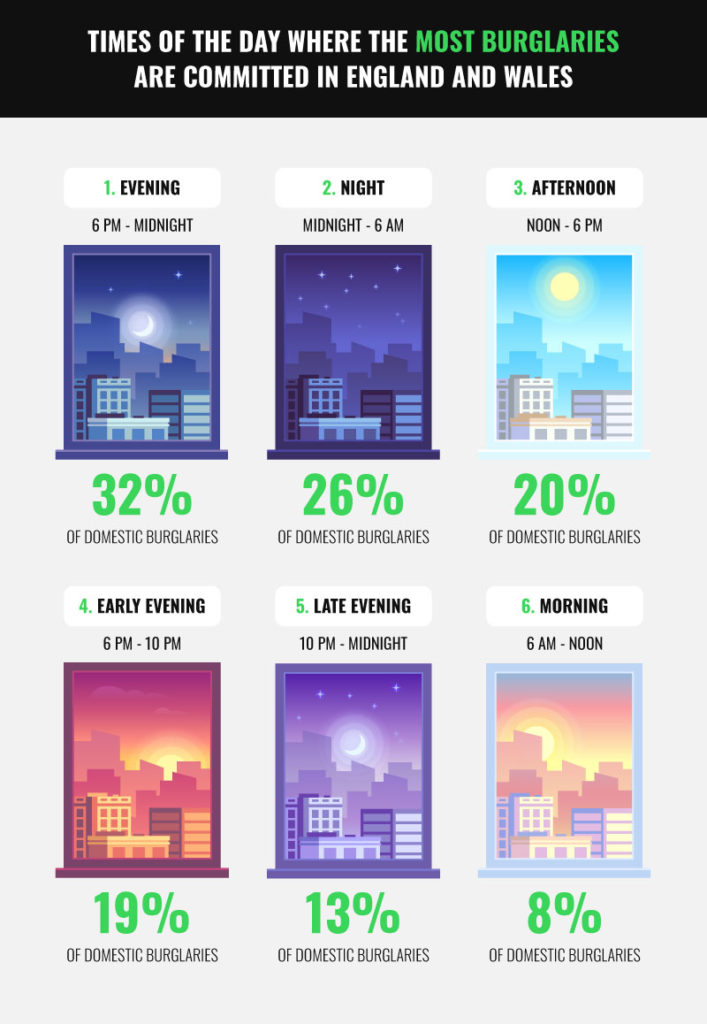
1.Evening – 32%
According to government data, over a third of domestic burglaries across England and Wales are committed during the evening. The most common time for a burglar to strike is between 6 pm and midnight, likely due to dark lighting and the possibility that homeowners will be out of the house.
2. Night – 26%
The night is generally considered one of the most dangerous times due to a lack of visibility and there being few people on the streets. Despite not being the most common time for a burglary, nighttime incidents make up around a quarter of all household burglaries, so you should still take precautions to increase the security of your home during this time.
3. Afternoon – 20%
You may be surprised to discover that a fifth of all domestic burglaries occur during the afternoon and in broad daylight. While it may seem foolish to carry out a burglary during the day, people are likely to be out of their houses at this time.
Having said this, since the COVID-19 pandemic, the world has seen a massive spike in the number of people working from home, so future editions of this data may see a decrease in the number of burglaries during this time of the day.
Burglars are most likely to enter the front of your house, with this point of entry making up around 60% of all incidents
In TV and film, burglars are commonly depicted sneaking around the back of houses, but is this true in real life? Here’s what we found.
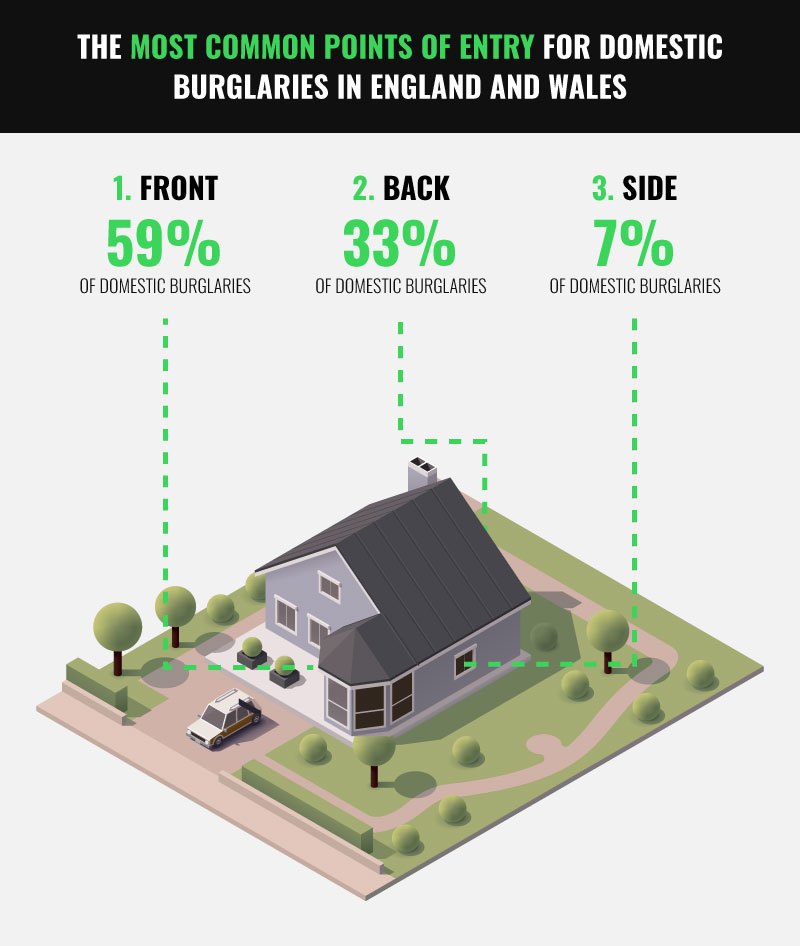
1.Front – 59%
With 59% of all domestic burglaries happening through the front of a person’s house, this is clearly the most common entry point. This method is often inconspicuous as, to passersby, burglars can give the impression that they are residents of the targetted home. With this in mind, it is paramount that you find a safe space for any spare house keys and remember to lock your front door if your house is to be left unsupervised.
2. Back – 33%
Even though a burglar will look shifty if a member of the public spots them climbing around the back of a house, this point of entry is commonly practised by thieves due to the lack of disturbance compared to alternative entrances – this is likely why 33% of all domestic burglaries commence at the back of a house.
3. Side – 7%
The third most common point of entry for burglars is the side of the house, which makes up 7% of all domestic burglaries across England and Wales. Whether the side of your home has windows, doors or both, it is essential to keep this area secure if you want to keep out intruders.
Making up 76% of all domestic burglaries, the most common method of entering is through the door
The following list reveals which methods of entry are the most commonly used by burglars. It is worth noting that respondents could choose multiple responses, which is why the total exceeds 100%.
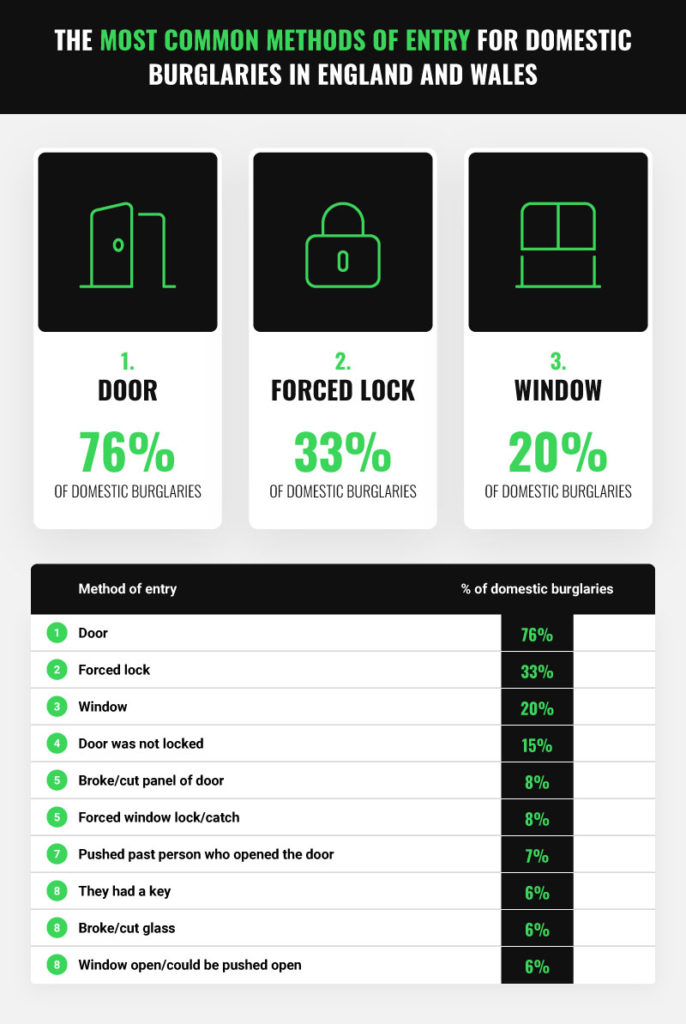
1.Door – 76%
For burglars, the most common method of entry is through a door, which makes up over three-quarters of all domestic burglaries in England and Wales. Thieves who use doors as an entry method may scope out a house beforehand to see how to access it, or they may just try their luck. Either way, securing your doors is paramount for keeping burglars out.
2. Forced Lock – 33%
Forcing a lock open is one of the oldest tricks in the book for burglars, and it remains a standard method of entry across England and Wales. Contributing to a third of all domestic burglary incidents, forcing open a lock does not require specialist tools and produces minimal noise, making it a popular option among crooks.
You can protect your home against this method of entry by integrating anti-snap locks and installing a home alarm system to detect intruders who may sneak in if they manage to pick your lock.
3.Window – 20%
The third most common method of entry for burglars is through a window, accounting for a fifth of all domestic burglaries in England and Wales. Thieves can enter quickly through your window if left open and unattended, so ensuring all openings are shut before leaving the house is essential. Burglars can also gain access by smashing a window open, but this is not a subtle method and is much less common.
Outside doors are damaged/broken more often than anything else during domestic break-ins – occurring in more than 55% of incidents
Unfortunately, even the most secure homes can be the target of burglaries, often leading to damaged property, but which type of damage is the most common? Here’s what we found.
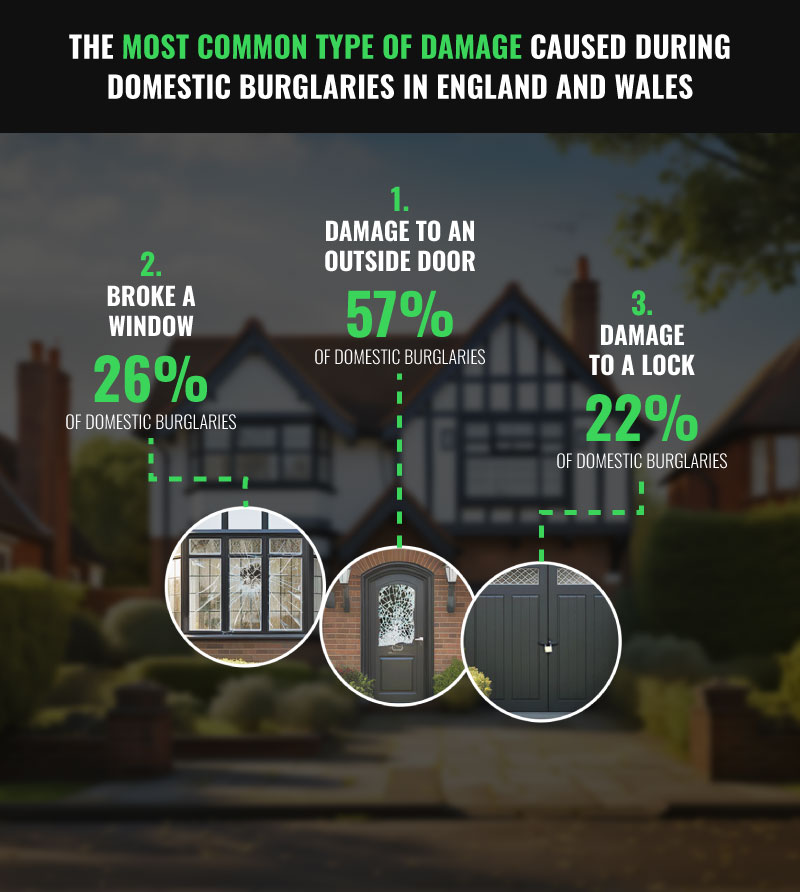
1.Broke/ damage to an outside door – 57%
After doors were revealed as the most common method of entry in an earlier ranking, it may be no surprise that damage to an outside door has occurred in more domestic burglary incidents than any other type of damage. Of all the break-ins in England and Wales where damage has occurred, 57% have involved a broken or damaged door.
2. Broke a window – 26%
The second most common type of burglary-related damage is a broken window. Despite being a noisy form of property destruction, this is present in 26% of all domestic burglaries where some damage has occurred.
3. Damage to lock – 22%
Locks can be found on windows and doors, and when all openings to a house are shut, this type of damage is how a burglar can access a property. Damages to locks have been present in more than 20% of all domestic burglary cases in England and Wales – the third most common type of damage on this list.
Almost 60% of domestic break-ins incur no damage cost
From a broken lock to a shattered window, the extent of damage caused by burglars can massively differ in value. The following list reveals the average cost of burglar-related damage across England and Wales.
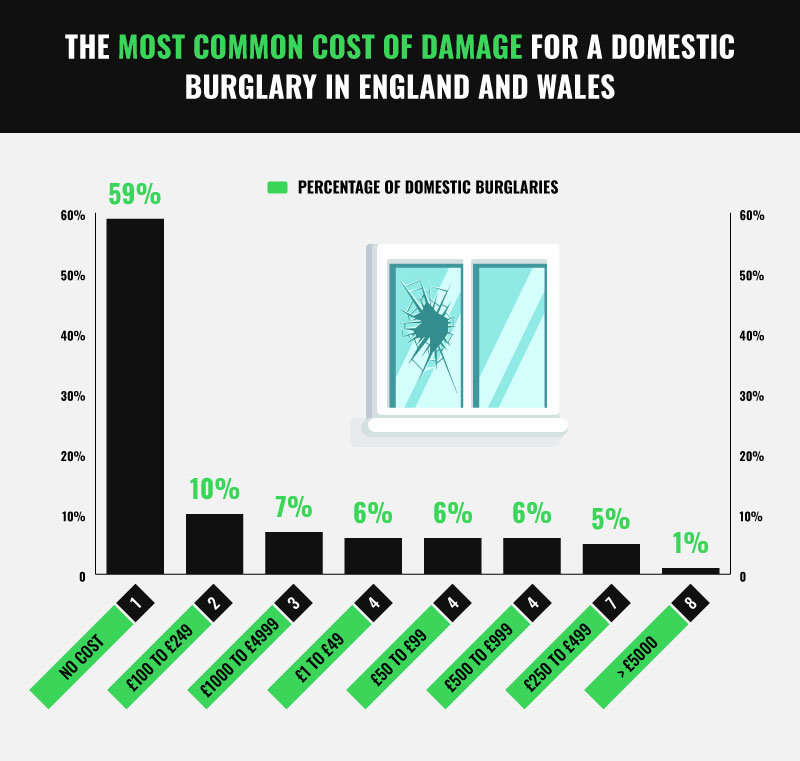
1.No cost – 59% of all domestic burglaries
When it comes to domestic burglaries, figures reveal that, more often than not, incidents of break-ins have no associated damage costs. The 59% of cases in this sample include incidents where there were no reported damages, likely due to victims leaving their doors/ windows unlocked, which gives any intruders easy access.
2. £100 to £249 – 10% of all domestic burglaries
Around 10% of all domestic burglaries incur a damage cost of between £100 – £249. If you don’t have the money for home security systems but would like a simple but effective way to deter burglars, look no further than decoy CCTV stickers. By having these on display, prospective burglars may incorrectly believe they are being recorded, reducing the likelihood of them destroying your property.
3. £1000 to £4999 – 7% of all domestic burglaries
Unfortunately, damage incurred during domestic burglaries can be very costly. In 7% of burglary incidents across England and Wales, damage caused by robbers is valued between £1000 – £4999. Investing in a home security system could protect you and your house from intruders and potentially save you a lot of money.
Purses, wallets, money, and cards are stolen in 40% of domestic burglaries – more common than any other item
Most burglars enter a house intending to steal valuables, but which items are most commonly robbed in England and Wales? Here’s what we found.
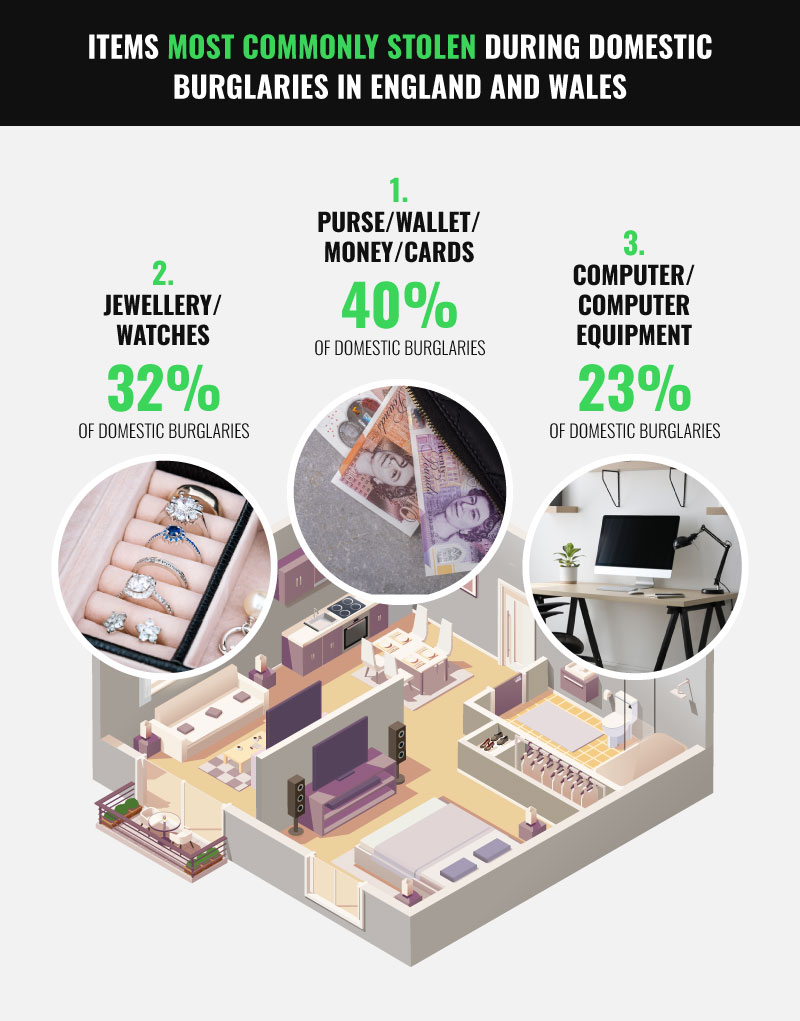
1.Purse/wallet/money/cards – 40% of all domestic burglaries
Given that the primary purpose of purses/wallets is to help store your monetary items, it may be unsurprising that this is the target item for many burglars. The easiest way to reduce the chances of your money holder being stolen is to hide it in a safe place at night, such as a locked drawer.
2. Jewellery/watches – 32% of all domestic burglaries
Whether handed down through generations or given as a gift, bling is often a person’s pride and joy. However, for many, their most expensive jewellery is only worn on special occasions. Unfortunately, burglars are taking advantage of this, evidenced by the fact that 32% of all domestic burglaries in England and Wales involve a stolen watch or jewellery item.
3. Computer/computer equipment – 23% of all domestic burglaries
According to the most recent government data, computers and computer equipment are the third most sought-after items for burglars. Theft of this calibre occurs in around 23% of all domestic burglaries, but unlike other things on our list, it can be more challenging to hide a computer from thieves.
Despite this, there are ways you can add an extra source of protection to your devices, including keeping your computer in a locked room or installing a tracker so that you can find your items if anything were to happen. Closing your blinds can also help to hide any valuables and provide a source of external security.
Two-fifths of all domestic burglaries result in more than £1000 worth of stolen property
The following list reveals the average cost of a domestic burglary incident in England and Wales based on the percentage of burglaries falling in each cost bracket.
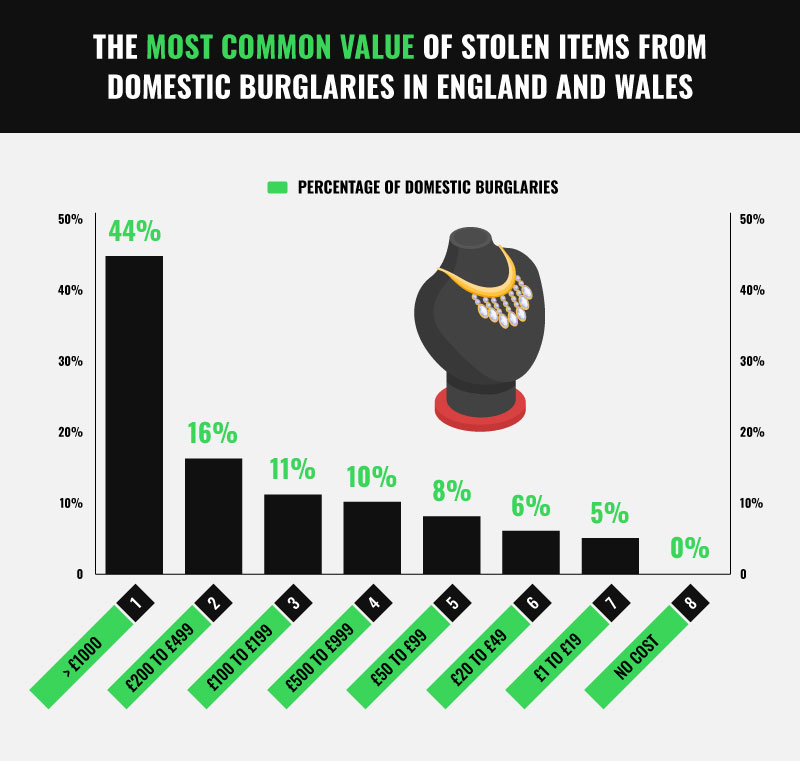
1.> £1000 – 44% of all domestic burglaries
Given that the most commonly stolen items include wallets, jewellery and computer equipment (as revealed in an earlier list), it is unsurprising that over 44% of all domestic burglaries accrue a total loss of £1000 or more.
2. £200 to £499 – 16% of all domestic burglaries
Around 16% of all domestic burglaries have a stolen item value of between £200-£499. These figures may seem like a small loss compared to £1000, but it is still a significant chunk of money to lose. Some items that could contribute to burglaries of this calibre include CDs, sports equipment and clothes, among others.
3. £100 to £199 – 11% of all domestic burglaries
According to the most recent government data across England and Wales, more than one in ten domestic burglaries result in a loss of between £100 and £199 – the third most common value of stolen items in this list.
58% of domestic burglary victims report anger – the most common of any emotional response
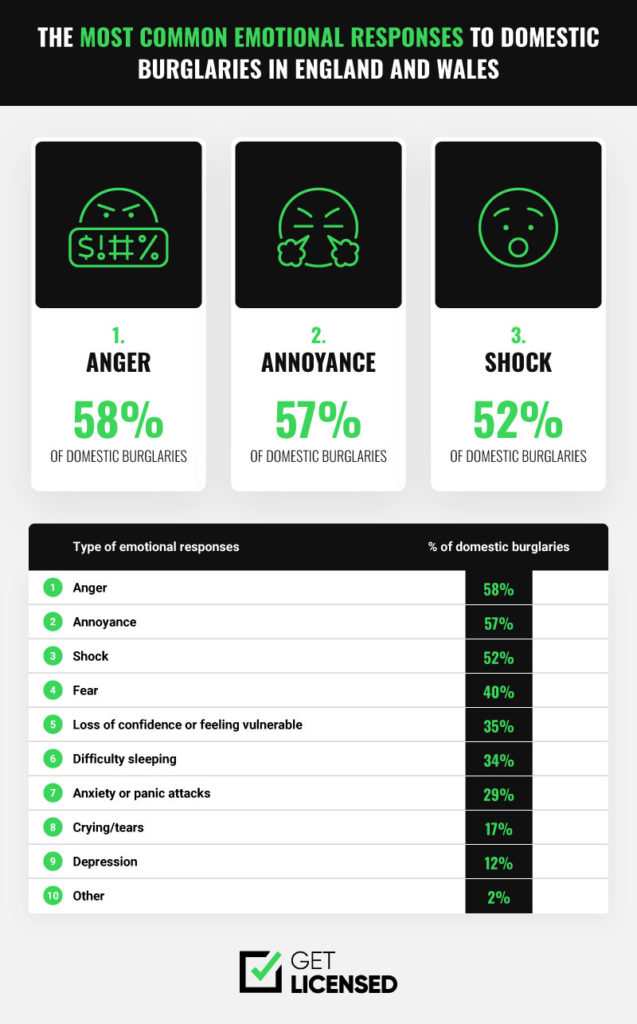
Regardless of the scale of the incident, it is normal for victims of burglary to feel some emotional response. The list below reveals the most common types of emotional reactions felt following domestic burglaries.
1.Anger – 58% of all domestic burglaries
The emotional response of anger can be described as rage towards someone or something who has done wrong to you. Given that domestic burglaries can result in the taking of a person’s belongings and feelings of security, it may be surprising that only 58% of victims in England and Wales report this type of feeling.
2. Annoyance – 57% of all domestic burglaries
Whether you are annoyed at yourself for leaving a window open or annoyed that you were taken advantage of, domestic burglaries can often leave victims with feelings of frustration.
According to the most recent edition of government data, around 57% of all domestic burglary victims reported feelings of annoyance. This emotional response can often lead to anger, which is why they are so close in commonality on this list
3. Shock – 52% of all domestic burglaries
The third most common type of emotional response is shock, which is experienced by just over half of all domestic burglary victims. Shock can affect people in many different ways, from going quiet to screaming and shaking. Still, more often than not, this type of emotional response is felt in one way or another by victims of domestic burglaries.
Methodology
We used GOV.UK to find the following data as of 2020 (these figures are from the most recent data edition as of November 2023):
- Timing of when incidents of all domestic burglary occurred. We removed any overlapping times, namely “morning/afternoon, “evening/night”, as well as any “unsure” timings.
- Point of entry in incidents of all domestic burglary in a dwelling. We removed any incidents which reported an entry of “more than one way”.
- Method of entry in incidents of all domestic burglary in a dwelling. We removed any incidents that fell into the category “other method”.
- Type of damage caused in incidents of domestic burglary in a dwelling.
- Cost of damage in incidents of all domestic burglary in a dwelling.
- Items stolen in incidents of domestic burglary in a dwelling with entry. We removed any repeating items, namely “Jewellery” and “Watches”.
- Cost of stolen items in incidents of domestic burglary with entry.
- Emotional impact of incidents of all domestic burglary in a dwelling.
The UK’s number 1 course finder
Best price guarantee
We offer price match if you find the same course cheaper elsewhere
100% money back guarantee
Get a full refund if you don’t like the course. Terms apply.
5-star customer support
Consistently rated 5-stars on review sites like Trustpilot
£0 booking fee
We never charge any booking or hidden fees
Instant eLearning access
Get FREE access to eLearning course materials instantly after you book
Top-rated training providers
Over 90% of our customers pass the exam in the first attempt

 Trustpilot
Trustpilot











